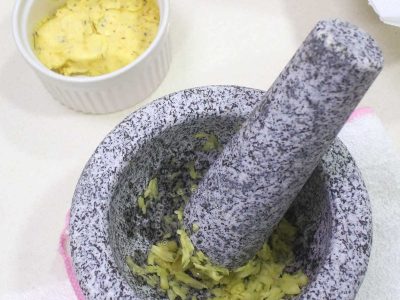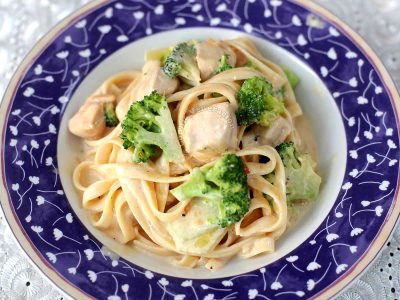Although the origin of fried rice is attributed to China, there are so many fried rice recipes beyond the Chinese borders. Some, like the ones found in Southeast Asia, may have have been influenced by Chinese traders and immigrants but, in the adaptation, variations multiplied.
This is about Chinese-style fried rice or, more specifically, how we cook it at home (note that we’re not Chinese). It’s a post about the procedure rather than a specific recipe. The vegetables used here may be changed, the Chinese sausage may be substituted with some other meat or even seafood and even the order in which the individual ingredients are cooked can be modified.
What rice is ideal for making Chinese-style fried rice? What is day-old rice?
The thing about fried rice is that the rice grains must be separated before stir frying. That means you can’t use sticky (a.k.a. glutinous) rice. Even if you leave cooked glutinous rice to cool overnight, the grains will still be stuck to one another a day later. That’s why it’s called sticky rice.
Taking that exception in mind, you can use any rice variety, really, so long as it’s NOT newly cooked and as long as the rice wasn’t cooked with too much water. Newly cooked rice contains a lot of moisture and moisture makes stir frying difficult. Rice cooked with too much water is soggy and the grains still have a tendency to stick together even when it is already a day old.
Again, you want to separate those rice grains before cooking fried rice. So, if you cook rice and you intend to turn any leftover into fried rice, use just enough water to cook the grains through. AND allow the rice to cool (and dry for several hours, ideally) before stir frying. That’s what’s often referred to as “day-old rice”.
Does that mean that brown rice or other whole-grain rice can be cooked into Chinese-style fried rice? Oh, yes! That was today’s lunch and what inspired me to update the how to cook Chinese-style fried rice tutorial. Note that you can also cook congee using brown rice.
About the eggs
There are two popular methods for the integration of eggs in Chinese-style fried rice. The first method is to cook the fried rice first, make a well in the center of the wok, pour in beaten eggs and slowly mix them into the rice by stirring in circles that go wider and wider to include more rice with every stroke. I do that when I’m too lazy to cook the eggs separately. My issue with this method is that the rice tastes too egg-y and that becomes the predominant flavor.

The more proper procedure is to cook the eggs separately. Heat a tablespoonful of oil, pour in beaten eggs seasoned lightly with salt and pepper, and stir the eggs around with a spatula to create volume and layers. Move the cooked eggs to a chopping board and cut up into uniformly sized pieces. Add the eggs to the fried rice toward the end of cooking time.
How much cooking oil do you need?
First, remember that this is stir frying and you want to use cooking oil with a high smoking point. How much cooking oil? That depends on how much vegetables, meat / seafood and rice you’re cooking.
Let me tell you, however, that you don’t need much. For the three cups of rice, a cup of vegetables, half a cup of meat and two eggs that I used for the fried rice in this post, I used two tablespoons of cooking oil. The first tablespoon was to cook the eggs; the second, for sauteeing the shallots and garlic. Two tablespoons only? Yes. I kid you not. When fried rice is cooked correctly, it isn’t greasy at all.
Creating a flavor base before adding the vegetables
For a truly good Chinese-style fried rice, you need to flavor the oil that will coat every grain of rice by the end of cooking time. How to do that? By sauteeing.

The most basic spices are garlic and shallots. Over medium heat, cook them with a sprinkle of salt and pepper until you can smell something good floating over the wok. Turn up the heat, add whatever chopped vegetables you’re using, sprinkle in more salt and pepper, and start stir-frying. The process goes fast from this point.
As a rule of thumb, the vegetables that take longer to cook should go into the wok first. Whatever vegetables take a shorter time to cook go in after a minute or so of stir frying. In this example, the carrot and bell pepper went ahead of the sweet peas.

Any cooked meat that you’re using goes into the pan after the vegetables. Why? Because the meat is already cooked and you’re really just heating it through.
The procedure would be different if, let’s say, you’re using raw shrimps. To avoid cooking them to death until they’re shriveled and rubbery, cook them separately as with the eggs. Scoop out, set aside and add toward the end of cooking time.
Season the rice
One serious mistake in cooking Chinese-style fried rice is over-seasoning the vegetables then adding the rice thinking that it will absorb the excess saltiness and everything will just balance out in the end. Hell, no.

Apart from the initial steps of cooking the eggs and sauteeing aromatics for a flavor base, Chinese-style fried rice is stir fried. High heat. Short cooking time. So short that over-salted vegetables will still taste over-salted while the rice will be bland. This is not a stew where over-salted meat can be cured by throwing in potatoes to soak up the salt.
So, season the vegetables sufficiently but never overdo it. When you add the rice, season it too. I like oyster sauce for seasoning the rice. You may choose soy sauce, fish sauce or even plain salt. It’s up to you. Then continue stir frying until the rice is heated through.

When the rice is heated through, it’s time to add the eggs that you had cooked and cut up earlier. Just throw them in and toss to distribute the lovely yellow pieces evenly.
The finishing touch: sesame seed oil
Turn off the heat, drizzle in about half teaspoonful of sesame seed oil and toss to blend. Taste the fried rice. If it needs more seasoning, now is the time to make adjustments.
How to serve Chinese-style fried rice

When Chinese-style fried rice is cooked with a generous amount of vegetables and meat or seafood, it can be a complete meal by itself. There used to be a joke in my family that when I make Chinese-style fried rice, you have to look really hard to find the rice among the vegetables and meat. Well, why not?
If, however, you’re serving the fried rice as a side dish, it is a better idea not to overcrowd it with too many things that may overpower the flavors of the main dish that you’re serving it with.
And that is how we cook Chinese-style fried rice. Like I mentioned earlier, there will be variations in the procedure depending on the ingredients you’re using. But if you understand the rationale behind every step, you’ll know when a slightly different procedure is called for and when to stick to the basics.







